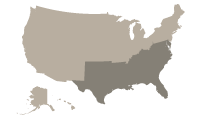
Permit
Permit are essentially shallow water, schooling fish occurring over sandy flats and reefs in depths from 1 to 17 fathoms.

Region
South
Catch ease
Medium
Habitat
Bay, Ocean
How to identify a Permit
It is distinguished from the common pompano by having fewer soft rays in the dorsal and anal fins. The second dorsal fin has 1 spine and 17-21 soft rays (22-27 in the pompano). The body is laterally compressed and the second and third ribs are prominent -- often as big around as ones thumb in fish weighing over 10 lb. (4-5 kg). These larger ribs can be felt through the sides of the fish and help in distinguishing the permit from the pompano. In overall appearance it is a silvery fish with dusky fins, though the back is usually bluish or grayish. The ventral fins and the anterior margin of the anal fin may be orange in some specimens. Often there is a triangular yellow patch before the anal fin.
Where to catch Permit
The permit can be found in the western Atlantic Ocean from Massachusetts, U.S.A. to Brazil, including the Gulf of Mexico and the West Indies. The greatest concentrations are off south Florida and it is there that the biggest specimens are taken. The following list includes additional details on where to catch this fish:
| Backflow |
| Bays |
| Breakers |
| Jetties and Breakwaters |
| Nearshore Reefs and Shoals |
| Schools |
| Surf and Shore |
| Baitfish Patches |
| Bays and Estuaries |
| Channel Entrances |
| Man-Made Structures |
| Ripples, Currents, Swirls and Sprays |
| Shore Points |
| Tidal Flats |
How to catch Permit
They feed in much the same way as bonefish, rooting in the sand on shallow flats. Their diet consists primarily of mollusks, crustaceans, sea urchins, and less commonly, of smaller fish.It is a tough fighter on light tackle. When hooked it makes an initial long, fast run toward deep water, twisting and pausing to bump its head on the bottom or rub its mouth in the sand in an effort to disengage the hook. If there is coral, a sea fan, or any other obstacle on which the permit can snag the line, it will. To complicate matters, its mouth is as tough as shoe leather and it simply spits out the hook the first time there is any slack in the line.Fishing methods include casting to fish sighted in shallow water, bottom fishing, fishing over inshore wrecks, and jigging from boats or while wading. Baits and lures include crabs, shrimp, streamer flies, bonefish jigs, weighted bucktails, and plugs. Permit up to 8 or 10 pounds are considered excellent eating. The following are fishing methods used to catch this fish:
Permit lures, tackle & bait
The following are lures, tackle or bait that can be used to catch this fish:
